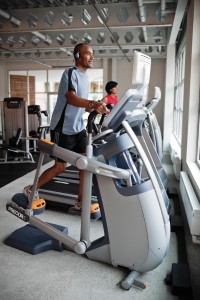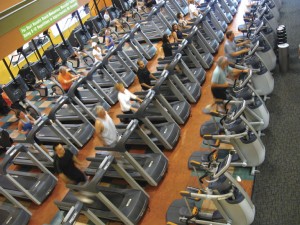
The fitness industry sees this consistent trend among members — justifying the large quantities of cardio equipment purchased by clubs around the U.S. For many years clubs have gotten by with typical treadmills, elliptical trainers, stair climbers and stationary bikes — until now. According to Ed Trainor, the vice president of fitness services and product development with Town Sports International, there has been a major shift in cardiovascular workouts in the last two to three years.
“People are starting to realize that low-impact training is better for the hips and back,” Trainor said. “Even runners want to know how they can train when they aren’t running so that they can run later in life.” This information can be crucial to the club that needs to know how to differentiate its cardio space and make purchases in the next two to five years. What this information doesn’t give clubs, is how to get members onto the equipment, and how to keep them exercising — that’s where this article takes over.
Advances in Cardio Equipment
Cardio equipment has come a long way from the treadmill or a stationary bike.
Today, cardio manufacturers have made vast improvements to try and help clubs with attrition and the “member experience.” Many newer pieces of equipment provide clubs and members with monitors to tell them how many calories they are burning, how far they are traveling and how fast they are moving. The modern stationary bike may tilt or adjust in many ways an actual bike would.
Machines today are attempting to give members more than they ever had in the past. Members are looking for iPod-docking stations; TV monitors and USB ports that can help them track their cardiovascular workouts.
“Most new trends center around the entertainment options a member has while on cardio equipment,” said Shawn Stewart, the operations manager for Gainesville Health and Fitness Clubs. “Virtual training, iPod features, Internet access, cardio movie theaters and on-demand workouts and movies are the latest trend.”
Doug Johns, the global marketing director for Precor Fitness, said that cardiovascular equipment trends take about five years to develop. “What may seem like a long time for a club with equipment that is three years old, may be new for a club down the street that just purchased the equipment,” he explained. “Integrated personal viewing screens are still an emerging trend even after it’s been around for a while. There is still a lot of upside left because it’s still boring to workout on cardio equipment when people can’t disassociate themselves from the exercise. The personal viewing screens are a big deal.”
Aside from the entertainment aspect, many clubs are looking to help members through exercise-tracking systems. “All manufacturers are trying to develop a tracking device,” Trainor said. “We went with Netpulse so that members don’t have to walk around with different tracking cards.” Every manufacturer is trying to make working out more interactive. One of the biggest ideas on the market right now is the tracking of the member’s progression.
According to Trainor, all personal trainers use cardiovascular exercises with their member training. However, the trainer doesn’t physically monitor many of the cardio workouts the trainers put members through.
With the use of a monitoring system, clients and trainers have the ability to track their progress and adjust their training appropriately. TSI has decided to use a tracking source that’s not created by the manufacturers. However, clubs have an option to go with the manufacturer’s system or an outside vendor.
By contacting a cardio manufacturer about tracking systems, products can be found that help members with tracking devices already built into the machine. Many members may only use one or two cardio machines during each visit. This means that using tracking systems provided by the manufacturers could be more cost efficient for smaller facilities.
As fitness professionals, you understand the importance of cardio training. However, you should also understand the amount of will power it takes to get your legs moving. The same situation can be assumed for all your members — probably on a greater level.
“Cardio training has become more functional over the years, but people are still looking for the fun factor,” explained Douglas Brooks, M.S., the leading exercise physiologist and fitness industry educator/presenter and director of education for RealRyder International LLC. “Equipment that offers multiple benefits, such as cardiovascular health improvements, movement in a variety of planes, increased coordination, balance and core activation — modalities with this combination represent the tool of choice by top coaches and trainers who want to improve their athletes’ sports performance or improve the general fitness level of the mainstream fitness consumer.”
Trainor said that members are starting to look for more low-impact training when it comes to cardio. Members will be more likely to continue with spinning classes, but will also look for elliptical machines and stair climbers.
Johns said that the science behind cardio training has become a lot more advanced than the typical member is ready for. “Unfortunately, most people use the same workout on the equipment each time they’re in the club,” he said. “Just by incorporating variety into the routine they could benefit more from their workout. That’s where a club team can step in and instruct members on how to use a couple of the programs. If they do, the member will be open to deeper fitness advice in the future.”
Also, by spending more time around the cardio equipment, Johns said trainers could put themselves in a better situation to obtain new clients. He said that cardio fitness acts as a key entry point for greater fitness and a richer life. “People get the call and they are going to start their fitness journey,” he continued. “Cardio is the simple entry point. One of the challenges is to get people to get off the cardio floor and get into a richer, fuller fitness experience using resistance training. For trainers in particular, there are a lot of opportunities to build relationships with new members in the cardio area.
“Ultimately, those folks need to come out of the cardio area,” Johns continued. “However, it offers them something they can do right away — as an industry, we have to get them to do more.”
According to Trainor, the average person comes into the club with knowledge of how important cardio training is. The struggle is to get the member to be consistent with their workouts. By utilizing modern equipment, members will be more inclined to frequent the club for their cardio needs.
Give your members the opportunity to come to the club and watch their favorite show while they run or use the elliptical trainer. Many clubs have brought in cardio cinemas to push members to stay in the club longer — once they are tied to a movie, they will spend more time in the club. They may not continue to run hard, but they may slow their pace to a brisk walk and watch the remainder of the movie.
Thinking Outside the Box
Cardiovascular exercise can easily be performed away from the typical treadmill or elliptical trainer. Companies like Hydra-Gym have found ways to develop cardio workouts with a muscular endurance workout that shapes and tones muscles.
“Many clubs may not be incorporating resistance training into their programs or may not have a program that is complete or safe,” said Brent Brentham, the president of Hydra-Gym. “Many people already understand the value of varied exercise programs, such as cross training or cross conditioning. Members are ready for more high tech, safe, organized programs that are effective, time efficient and cover all parameters of fitness.”
Stewart said the best trend for the fitness industry would be one that would help motivate members and keep them safe and active. This would be exercise that isn’t typical, but is fun and could keep the member engaged. “Our philosophy, and hopefully a future trend in the industry, is to create an incredible experience for members and provide instructors to coach, motivate and customize workouts as well as provide the latest in entertainment options,” Stewart said. “It’s important to build connectivity between the members so they have fun while training.”
“It is not essential to establish classes for beginner, intermediate and advanced members,” Brentham continued. “Participants should work at their specific heart rate and should not be influenced by the tempo of the music or ego. Vary the change-station-time intervals according to your class participants and formats. A 30-second interval is a good way to start and can accommodate all fitness levels and class formats.”
Certain Group X classes and new products like Hydra-Gym can help engage members in a different way than basic cardio workouts. These workouts can get quick results for your members by not only helping them lose weight, but also by helping them build and tone muscle.
Group X classes aren’t a traditional form of cardio training, but it gives members something outside of the typical cardio machine. Classes like Zumba and Les Mills amp up the heart while entertaining the members.
“Turn-key Group X programs are taking center stage,” said Jeffrey Perlman, the vice president of marketing for Zumba Fitness, LLC. “I see progressive fitness programs blurring the line between fitness and entertainment. The programs that survive are going to be the most entertaining programs.”
“Cardio group fitness classes provide supervised instruction and group camaraderie fulfilling a club initiative of ours to build staff-member relationships to retain members,” explained Scott Lewandowski, the regional fitness director for Fitness Formula Clubs in Chicago.
Marketing the Cardio Area
Many clubs in cooler environments can market the temperature cool down to get cardio enthusiasts back into the club. However, not all clubs have the luxury of promoting the cold temperatures. How can average clubs in moderate environments retain members through cardio equipment?
“The importance of retaining members for clubs can’t be understated,” said Jeff Meeks, the director of cardio product management for Star Trac Fitness. “The path to success there reaches far beyond equipment and is really a sum of the entire member experience a club provides. Cardio training equipment plays a key role in that experience as it is an integral part of most members’ exercise regimen.”
Because cardio takes up a significant portion of the club, it’s extremely prevalent on the club tour. Also, throughout the day, there is almost guaranteed to be someone on cardio equipment to show consumers the importance of cardio in a workout routine.
“We offer a variety of over 15 different types of cardio equipment and over 250 pieces, including elliptical trainers, treadmills, stair masters, step mills, recumbent and upright bikes and rowers,” Stewart explained. “We have two different cardio areas, each one over 3,000 square feet. Most of our 28,000 members do some form of cardio training, either on machines or in Group X. We educate members and regularly update their goals from their first day through their entire membership.”
“In a competitive region or even neighborhood, new, better looking, more technologically advanced, highly entertaining or simply different equipment can lead to taking members away from the competition,” Meeks continued. “A poor experience with equipment or even poor perception of the equipment in a facility can be damaging to the fragile club-member relationship.”
The sales team must understand the importance of cardiovascular training and they need to know how it can help people reach their goals. “Cardio training is extremely important,” explained Lewandowski. “Mainly new members join to either lose weight or tone their body through burning calories. New members generally are most familiar with the cardio equipment. Overall, the cardio equipment provides the least intimidation and usage learning curve for the member.”
Cardio equipment may not be an obvious marketing tool for the club. However, it’s easily the greatest and most comforting tool for attracting new members. Like Trainor explained, use the cardio to create a warm and inviting environment that any potential member can understand. -CS










Comments 0